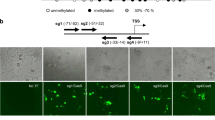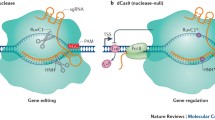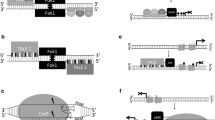Abstract
Regulating gene expression is important for basic research and therapeutic applications. The epigenome is a record of genetic modifications such as DNA methylation and histone modifications, and epigenetic changes can play a key role in modifying gene expression. With the advent of genome editing technologies, it has become possible to manipulate the epigenome of specific genomic regions to control gene expression. In particular, CRISPR–Cas9 systems have been used widely for epigenome editing due to their high efficiency, versatility, specificity, and ease of use. Here, we describe a protocol for the upregulation of specific genes using the dCas9-SunTag system.
Access this chapter
Tax calculation will be finalised at checkout
Purchases are for personal use only
Similar content being viewed by others
References
Timp W, Feinberg AP (2013) Cancer as a dysregulated epigenome allowing cellular growth advantage at the expense of the host. Nat Rev Cancer 13:497–510
Chatterjee A, Rodger EJ, Eccles MR (2017) Epigenetic drivers of tumourigenesis and cancer metastasis. Semin Cancer Biol 51:149–159
Mazzone R, Zwergel C, Artico M et al (2019) The emerging role of epigenetics in human autoimmune disorders. Clin Epigenetics 11:34
Urdinguio RG, Sanchez-Mut JV, Esteller M (2009) Epigenetic mechanisms in neurological diseases: genes, syndromes, and therapies. Lancet Neurol 8:1056–1072
Rosen ED, Kaestner KH, Natarajan R et al (2018) Epigenetics and epigenomics: implications for diabetes and obesity. Diabetes 67:1923–1931
Butler MG (2009) Genomic imprinting disorders in humans: a mini-review. J Assist Reprod Genet 26:477–486
Martella A, Fisher AI (2021) Elucidative role of CRISPR-based epigenetic modifiers and CRISPR-induced chromosome conformational changes. CRISPR J 4:1
Maeder ML, Linder SJ, Cascio VM et al (2013) CRISPR RNA-guided activation of endogenous human genes. Nat Methods 10:977–979
Perez-Pinera P, Kocak DD, Vockley CM et al (2013) RNA-guided gene activation by CRISPR-Cas9-based transcription factors. Nat Methods 10:973–976
Mali P, Aach J, Stranges PB et al (2013) CAS9 transcriptional activators for target specificity screening and paired nickases for cooperative genome engineering. Nat Biotechnol 31:833–838
Konermann S, Brigham MD, Trevino AE et al (2015) Genome-scale transcriptional activation by an engineered CRISPR-Cas9 complex. Nature 517:583–588
Breunig CT, Köferle A, Neuner AM et al (2021) CRISPR tools for physiology and cell state changes: potential of transcriptional engineering and epigenome editing. Physiol Rev 101:177–211
Morita S, Noguchi H, Horii T et al (2016) Targeted DNA demethylation in vivo using dCas9-peptide repeat and scFv-TET1 catalytic domain fusions. Nat Biotechnol 34:1060–1065
Tanenbaum ME, Gilbert LA, Qi LS et al (1997) A protein-tagging system for signal amplification in gene expression and fluorescence imaging. Cell 159:635–646
Morita S, Horii T, Kimura M et al (2020) Synergistic upregulation of target genes by TET1 and VP64 in the dCas9-SunTag platform. Int J Mol Sci 21:1574
Acknowledgments
This work was supported by the Basic Science and Platform Technology Program for Innovative Biological Medicine from the Ministry of Education, Culture, Sports, Science and Technology (MEXT), Japan, and by the Japan Agency for Medical Research and Development (AMED).
Author information
Authors and Affiliations
Corresponding author
Editor information
Editors and Affiliations
Rights and permissions
Copyright information
© 2023 The Author(s), under exclusive license to Springer Science+Business Media, LLC, part of Springer Nature
About this protocol
Cite this protocol
Morita, S., Horii, T., Hatada, I. (2023). Regulation of Gene Expression Using dCas9-SunTag Platforms. In: Hatada, I., Horii, T. (eds) Epigenomics. Methods in Molecular Biology, vol 2577. Humana, New York, NY. https://doi.org/10.1007/978-1-0716-2724-2_13
Download citation
DOI: https://doi.org/10.1007/978-1-0716-2724-2_13
Published:
Publisher Name: Humana, New York, NY
Print ISBN: 978-1-0716-2723-5
Online ISBN: 978-1-0716-2724-2
eBook Packages: Springer Protocols




